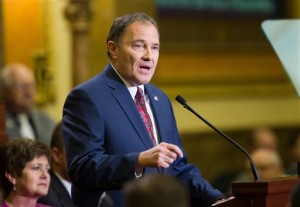
Utah state legislators will meet for a special session on Wednesday, May 18 to discuss opposition for a proposed national monument and the restoration of nearly $4 million in education initiatives.
Gov. Gary Herbert, R-Utah, called for the special session, which coincides with regularly scheduled interim meetings on May 18.
According to a press release, there are two items on the agenda for the special session. The first is a restoration of funds for education items in S.B. 2, which would include $1.5 million for pre-K education and $3 million for K-3 reading education. The second and more contentious issue is a concurrent resolution opposing unilateral designation of a national monument in Utah’s San Juan County.
“It is absolutely irresponsible for the Obama Administration to consider a new national monument that is over two and a half times the size of Rhode Island without input from Utahns from across the state who will be significantly impacted by this decision,” Gov. Herbert says in an April 16 news release. “As governor of the State of Utah, I have stated repeatedly that I oppose such a declaration. Today, I am asking every member of the Utah State Legislature to go on record and join me in expressing our opposition to another unilateral national monument within the state.”
According to the press release, cabinet members in the Obama administration have told Hebert that “no national monument will be designated in Utah without an open, public process occurring first.”
The proposed monument at Bears Ears in San Juan County would be 1.9 million acres. Members of the Bears Ears Inter-Tribal Coalition — which includes members of the Hopi tribe, Navajo Nation, Ute Mountain Ute Tribe, Pueblo of Zuni and Ute Indian Tribe — say the monument is necessary to protect sacred lands threatened by off-road vehicles and looting.
According to the Bears-Ears Inter-Tribal Coalition, “(Bears Ears) is a place many native peoples in the Four Corners area continue to define as home, soul and the setting for the cultivation of cultures.” The landscape, its ancient shrines, petroglyphs, plants, animals and cultural artifacts have become a “center of desecration, looting and disrespect.”
“The proposed Bears Ears national monument will provide much needed protection for this nation’s most rich cultural landscape,” says Jim Enote, director of A:shiwi A:wan Museum and Heritage Center in New Mexico.
Utah officials fiercely opposed to the monument say it’s overly broad and will hurt local economies. Gov. Gary Herbert, U.S. Senators. Mike Lee and Orrin Hatch, Utah’s four members of Congress and southern Utah County Commissioner Rebecca Benally all signed a letter delivered April 29 to the White House.
“With the strike of his pen, Obama could issue a national monument,” said Jon Cox, the governor’s communication director. “The governor believes it’s inherently a flawed process.”
This discussion doesn’t mean state officials don’t want the monument, Cox said; they just want Utahns to have a voice in the process. There are other ways to conserve the land, for example, a Public Lands Initiative could conserve the land but not until going through state channels and votes.
“This happened 20 years ago; we’re not strangers to it,” Cox said, referring to the 1.8 million acre Grand Staircase-Escalante National Monument that President Bill Clinton designated in 1996. State officials did not know of the designation until 24 hours before the declaration ceremony.
The Associated Press contributed to this report.




